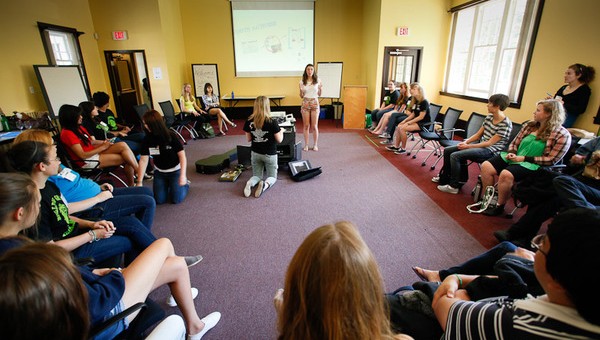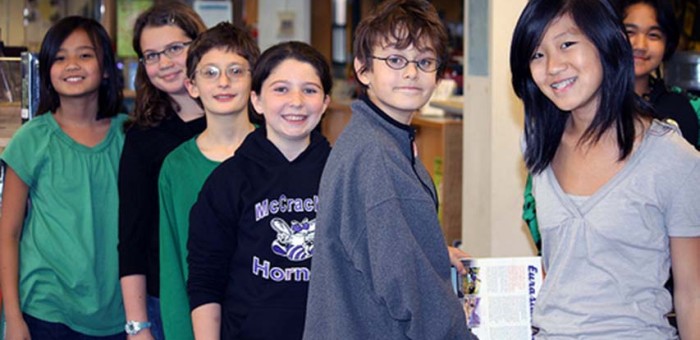Children and Family
Celebrating youth in our community – Erin Attwell
This is the 20th in our series of stories celebrating the outstanding accomplishments of youth in our community. These inspirational young adults are enriching our lives with their passion and commitment to the betterment of society.
Erin Attwell
 In 1929 the Hungarian writer Frigyes Karinthy put forth the notion that each and every person is only six degrees of separation from one another. But anyone who has lived in Victoria for a few years knows that it’s more like one degree of separation, or two degrees at most, within our community. And in the case of Erin, it is no different.
In 1929 the Hungarian writer Frigyes Karinthy put forth the notion that each and every person is only six degrees of separation from one another. But anyone who has lived in Victoria for a few years knows that it’s more like one degree of separation, or two degrees at most, within our community. And in the case of Erin, it is no different.
I first met Erin when she was three years old. She was a year younger than my son and both were attending Lambrick Park Preschool. Twenty years earlier, her father and I played rugby together at UVic and I was a TA for his Calculus class. While I periodically saw her father on the Tyndall turf coaching his son’s (and Erin’s twin brother’s) soccer team, I had no idea what Erin had been up to since preschool. So you can imagine my surprise when I learned on social media that the Erin Attwell recently won the overall General Classification cycling Yellow Jersey and Gold Medal at the Tour de la Rèleve de Rimouski.
 Erin was born in Victoria and attended Frank Hobbs Elementary School from kindergarten to Grade 5. In Grade six she enrolled in Maria Montessori Academy where she is currently entering Grade 11. Maria Montessori Academy is a small school with 300 students from kindergarten to Grade 12. Erin loves the small school and sense of community there. She describes it as a supportive learning environment with self-directed learning and a focus on independence. Students in grades 9 through 12 work together on projects in a common area. Her grade 10 class had 10 students and there were 7 students in the grad class of 2015. The Montessori philosophy teaches students to manage their own community and teachers facilitate learning through coaching and mentoring. Erin notes that there is no bullying at the school and learning is a very positive experience where students learn self-discipline and how to work together.
Erin was born in Victoria and attended Frank Hobbs Elementary School from kindergarten to Grade 5. In Grade six she enrolled in Maria Montessori Academy where she is currently entering Grade 11. Maria Montessori Academy is a small school with 300 students from kindergarten to Grade 12. Erin loves the small school and sense of community there. She describes it as a supportive learning environment with self-directed learning and a focus on independence. Students in grades 9 through 12 work together on projects in a common area. Her grade 10 class had 10 students and there were 7 students in the grad class of 2015. The Montessori philosophy teaches students to manage their own community and teachers facilitate learning through coaching and mentoring. Erin notes that there is no bullying at the school and learning is a very positive experience where students learn self-discipline and how to work together.
 From a very young age, Erin learned to ride a bike. Her Dad, a competitive cycling racer himself, got her on a bike “as soon as I could walk” and it was the beginning of her passion for cycling. She remembers having so much fun on rides with her Dad and many great times mountain biking at Hartland, a popular riding area at Mount Work Regional Park in Victoria.
From a very young age, Erin learned to ride a bike. Her Dad, a competitive cycling racer himself, got her on a bike “as soon as I could walk” and it was the beginning of her passion for cycling. She remembers having so much fun on rides with her Dad and many great times mountain biking at Hartland, a popular riding area at Mount Work Regional Park in Victoria.
Less than a year ago, Erin began cycling competitively when she joined the youth program of Tripleshot Cycling Club. She has done remarkably well in competition. As a rookie cyclist and member of the Tripleshot development team, Erin recently attended the Canadian National Junior (racing “up” in the age category U19 as a U17) Championship followed by the Tour de la Rèleve de Rimouski. At the Global Relay Canadian National Junior Cycling Championships, Erin won bronze in the individual time trial over a very difficult hilly course. Erin then went on to win 4th place in both the Road Race and the Criterium (a criterium is a bike race held on a short course, often run on closed-off city streets). This was not Erin’s first national experience as she won silver in the omnium at the Canadian Cycling’s national junior track championship in November 2014 in Burnaby, BC.
 After the excitement of nationals, Erin went on to Rimouski, Quebec for the 5 stage Rimouski Internationale Tour de la Releve, where she was a guest rider with ‘Team NCCH p/b DEC Express’ coached by Rick Lee. Erin was on the Cadet team of four young ladies who won silver in the Team Time Trial. Erin went on to win the first long 78 km race, the 15 km Individual Time Trial, the 35 km Criterium and a brutally hilly and windy 76 km Road Race – these impressive wins gave Erin the overall General Classification Yellow Jersey and Gold Medal.
After the excitement of nationals, Erin went on to Rimouski, Quebec for the 5 stage Rimouski Internationale Tour de la Releve, where she was a guest rider with ‘Team NCCH p/b DEC Express’ coached by Rick Lee. Erin was on the Cadet team of four young ladies who won silver in the Team Time Trial. Erin went on to win the first long 78 km race, the 15 km Individual Time Trial, the 35 km Criterium and a brutally hilly and windy 76 km Road Race – these impressive wins gave Erin the overall General Classification Yellow Jersey and Gold Medal.
Next on Erin’s agenda is racing against adult women at BC Superweek, followed by the Rapha Pacific Northwest Juniors Classic Stage Race in Elma Washington, then onto the Western Canada Summer Games in Wood Buffalo, Alberta as a member of Team BC. Her season will continue with Track Provincials in Victoria in August and then Nationals in October at the newly-built Pan-Am velodrome in Milton, Ontario.
 All this achievement has required a high dedication to training and considerable sacrifice. As Erin says, “doing something you love, you make sacrifices”. Her goal is to represent Canada at the World Championships and the Olympics. She says that her determination as a competitor has been inspired by her father. Others who have inspired and supported Erin are her personal coach Lister Farrar who has taught her to “never give up” and Peter Lawless, an accomplished lawyer and coach, who has been appointed Team Canada’s Ombudsperson for the Toronto 2015 Parapan American Games and the Rio 2016 Paralympic Games.
All this achievement has required a high dedication to training and considerable sacrifice. As Erin says, “doing something you love, you make sacrifices”. Her goal is to represent Canada at the World Championships and the Olympics. She says that her determination as a competitor has been inspired by her father. Others who have inspired and supported Erin are her personal coach Lister Farrar who has taught her to “never give up” and Peter Lawless, an accomplished lawyer and coach, who has been appointed Team Canada’s Ombudsperson for the Toronto 2015 Parapan American Games and the Rio 2016 Paralympic Games.
 Erin has also received inspiration from Pro Rider Mical Dyck, who likes to ride with and mentor junior riders. Mical has been a role model for many and champions equity for girls and women in sport. Erin has recognized that the sport of cycling does not provide equal opportunities for males and females – and she believes (as do we) that needs to change. There are fewer opportunities for women and the prize money for winning a race is substantially less (sometimes 50% less than prizes for male winners). Erin will champion and support the Ride Like a Girl initiative to get more women and girls into mountain biking so they can experience the joy of the sport.
Erin has also received inspiration from Pro Rider Mical Dyck, who likes to ride with and mentor junior riders. Mical has been a role model for many and champions equity for girls and women in sport. Erin has recognized that the sport of cycling does not provide equal opportunities for males and females – and she believes (as do we) that needs to change. There are fewer opportunities for women and the prize money for winning a race is substantially less (sometimes 50% less than prizes for male winners). Erin will champion and support the Ride Like a Girl initiative to get more women and girls into mountain biking so they can experience the joy of the sport.
Starting in September, Erin is very excited to be entering the prestigious and highly competitive Pacific Institute for Sport Excellence (PISE) program. PISE’s mission is to ‘enhance the development of sport and physical activity excellence through a partnership approach delivering world class programs, education, innovation and facilities’. She will spend half-days at PISE four days a week, including 2.5 hours daily in the gym. The program at PISE is for athletes in all range of sports, where cross training and nutrition are emphasized. PISE has a teacher on site to assist students with their academic studies. Speaking of academics, Erin loves science and wants to enter the medical field to become a physician (like her father).
 Erin is an incredibly impressive young woman with a brilliant future ahead of her. She has the determination and drive necessary to succeed at the highest level. Her enthusiasm for the sport and dedication to ensure that girls and women are provided with equal opportunities bode well for the future of women’s cycling in Canada. Erin will make a terrific mentor herself someday and young girls will look up to her as an exceptional role model. She is mature beyond her years and we wish her every success on her journey.
Erin is an incredibly impressive young woman with a brilliant future ahead of her. She has the determination and drive necessary to succeed at the highest level. Her enthusiasm for the sport and dedication to ensure that girls and women are provided with equal opportunities bode well for the future of women’s cycling in Canada. Erin will make a terrific mentor herself someday and young girls will look up to her as an exceptional role model. She is mature beyond her years and we wish her every success on her journey.
Celebrating youth in our community – Jillian McCue
This is the nineteenth in our series of stories celebrating the outstanding accomplishments of youth in our community. These inspirational young adults are enriching our lives with their passion and commitment to the betterment of society.
Jillian McCue
 I first met Jillian in April 2013. During the election campaign a number of meet and greets were hosted throughout the riding. On this particular evening, we rented the Saanich Fusion clubhouse on Tyndall Road to provide a venue for Gordon Head residents to raise and discuss issues of their choice. Mid way through the evening, a nine-year-old girl entered the clubhouse and asked me if I could ask the audience to sign her petition. I had no idea who she was and I was of course a little leery so I asked the young girl what it was for. She explained that she wanted to petition Saanich to allow miniature goats in back yards like in Seattle. I was impressed by her passion and commitment and offered Jillian McCue the floor to pitch her cause to the crowd. By the time that she was done, every single person in the room had signed the petition. I had no idea that two years later this remarkable young girl would likely realize her dream. After presenting to Saanich Council and subsequently three of its advisory committees, last week Saanich’s Environment and Natural Areas Advisory Committee, chaired by Councillor Dean Murdock, recommended that a feasibility study be conducted and that a pilot project be set up in Jillian’s back yard!
I first met Jillian in April 2013. During the election campaign a number of meet and greets were hosted throughout the riding. On this particular evening, we rented the Saanich Fusion clubhouse on Tyndall Road to provide a venue for Gordon Head residents to raise and discuss issues of their choice. Mid way through the evening, a nine-year-old girl entered the clubhouse and asked me if I could ask the audience to sign her petition. I had no idea who she was and I was of course a little leery so I asked the young girl what it was for. She explained that she wanted to petition Saanich to allow miniature goats in back yards like in Seattle. I was impressed by her passion and commitment and offered Jillian McCue the floor to pitch her cause to the crowd. By the time that she was done, every single person in the room had signed the petition. I had no idea that two years later this remarkable young girl would likely realize her dream. After presenting to Saanich Council and subsequently three of its advisory committees, last week Saanich’s Environment and Natural Areas Advisory Committee, chaired by Councillor Dean Murdock, recommended that a feasibility study be conducted and that a pilot project be set up in Jillian’s back yard!
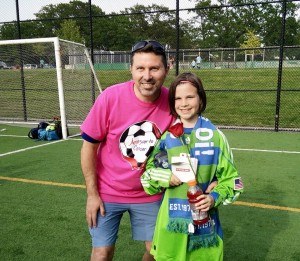 Jillian is a Grade 6 student at Gordon Head Middle School. She is the youngest of 5 children in her family, with three older brothers and one older sister. Jillian has loved playing soccer since age 7 and will be playing in the Under 13 (Gold) division in the fall – the first year playing on the full size field. She also loves gymnastics and cross-country running.
Jillian is a Grade 6 student at Gordon Head Middle School. She is the youngest of 5 children in her family, with three older brothers and one older sister. Jillian has loved playing soccer since age 7 and will be playing in the Under 13 (Gold) division in the fall – the first year playing on the full size field. She also loves gymnastics and cross-country running.
Jillian is an 11 year old who has for over two years now embarked on a mission. Few youth her age are as engaged as Jillian is in her community and especially in municipal politics. She became keenly interested in miniature goats as pets at the age of nine after she was introduced to two backyard-dwelling goats that belonged to family friends who lived in San Bernardino, California. Jillian, who appropriately was born in the Year of the Goat, took an instant liking to the goats and thought it would be wonderful to have a goat or two in her own back yard. Discovering that Saanich municipal by-laws did not permit the keeping of goats in urban areas, Jillian set out to change that.
 Jillian did her homework and undertook her own research. She learned that Seattle City Council had approved keeping miniature goats as pets in 2007. An article in the Seattle Post-Intelligencer noted that “female and neutered goats do not generate significant odors”. Wanting to test this for herself, Jillian embarked upon her own scientific research with the “Goat Poo Smell Study”. The driving questions for her research were:
Jillian did her homework and undertook her own research. She learned that Seattle City Council had approved keeping miniature goats as pets in 2007. An article in the Seattle Post-Intelligencer noted that “female and neutered goats do not generate significant odors”. Wanting to test this for herself, Jillian embarked upon her own scientific research with the “Goat Poo Smell Study”. The driving questions for her research were:
1) Do Victoria residents find that dog poo is more smelly than miniature goat poo?
2) How much more or less smelly is dog poo than miniature goat poo?
and her hypothesis was that goat poo did not smell as bad as dog poo.
 Participants in the study (32 in total) rated from 1 to 5 (a Likert Scale) the smelliness of two bags (bag A or bag B) of unidentified droppings (one was from a dog; the other from a goat). Her survey data confirmed her hypothesis. On average, dog droppings smelled twice as bad as goat droppings. The survey was done at an ideal location – Beacon Hill Petting Zoo, a place Jillian loves to visit and play with the miniature goats.
Participants in the study (32 in total) rated from 1 to 5 (a Likert Scale) the smelliness of two bags (bag A or bag B) of unidentified droppings (one was from a dog; the other from a goat). Her survey data confirmed her hypothesis. On average, dog droppings smelled twice as bad as goat droppings. The survey was done at an ideal location – Beacon Hill Petting Zoo, a place Jillian loves to visit and play with the miniature goats.
Armed with her research study, a pro-goat petition signed by 132 people in her neighbourhood (including me from that April 2012 event) and a well put together powerpoint presentation that demonstrated her knowledge about goats, Jillian headed to a Saanich Council meeting in May of this year. Her thoroughly researched and powerful presentation addressed the common misconceptions concerning miniature goats; it also detailed the positive aspects of having backyard goats in urban areas. Jillian easily handled questions posed to her by Councillors after her presentation. After further deliberations, Saanich Council referred the matter to three committees. Jillian had her work cut out for her in the lead up to the three additional presentations she gave in June.
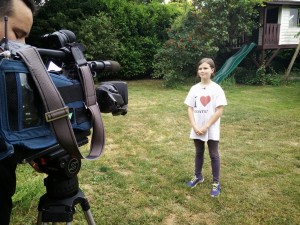 Two years after undertaking this mission, Jillian has learned a tremendous amount about goats and municipal politics. She has met with elected politicians, learned how to execute a petition, conducted research, learned to give persuasive presentations to council and committees and garnered considerable media attention. Television, radio and newspapers all picked up the story, including CTV (twice), CHEK (twice), CBC, CFAX, Ocean 98.5, Times-Colonist and Saanich News. Having to give ten media interviews following an appearance before Saanich Council would be a daunting task for most adults, let alone an 11 year old, but Jillian handled it like a pro. She won’t give up and pledges to persevere with the hope for a positive outcome from Saanich at an upcoming Council meeting.
Two years after undertaking this mission, Jillian has learned a tremendous amount about goats and municipal politics. She has met with elected politicians, learned how to execute a petition, conducted research, learned to give persuasive presentations to council and committees and garnered considerable media attention. Television, radio and newspapers all picked up the story, including CTV (twice), CHEK (twice), CBC, CFAX, Ocean 98.5, Times-Colonist and Saanich News. Having to give ten media interviews following an appearance before Saanich Council would be a daunting task for most adults, let alone an 11 year old, but Jillian handled it like a pro. She won’t give up and pledges to persevere with the hope for a positive outcome from Saanich at an upcoming Council meeting.
We were not surprised when Jillian told us she “always puts her hand up in class” and “likes public speaking and talking to adults”. Apparently, it takes her a long time to deliver papers on her paper route because she frequently stops and talks to people in their gardens along the way.
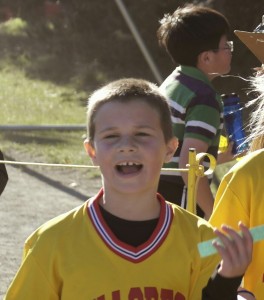 Jillian’s numerous other activities including babysitting (she has completed the babysitter training course), volunteering her time to help serve homeless people in the community and participating in fundraising events for Hospice and the Cancer Society. In one cancer campaign she shaved her head and raised over $1,000.00 by going door to door in her neighbourhood. Shortly after shaving her head, she was in the city finals for cross country and was mistaken for a boy and placed in the wrong chute – placing her in 58th place when she actually came in 2nd in her girl’s age category race. As the photo to the left illustrates, this was somewhat confusing for Jillian when she received her 58th place participation paper (instead of a 2nd place ribbon), but it all got worked out and, once again, she handled herself with maturity (and good humour).
Jillian’s numerous other activities including babysitting (she has completed the babysitter training course), volunteering her time to help serve homeless people in the community and participating in fundraising events for Hospice and the Cancer Society. In one cancer campaign she shaved her head and raised over $1,000.00 by going door to door in her neighbourhood. Shortly after shaving her head, she was in the city finals for cross country and was mistaken for a boy and placed in the wrong chute – placing her in 58th place when she actually came in 2nd in her girl’s age category race. As the photo to the left illustrates, this was somewhat confusing for Jillian when she received her 58th place participation paper (instead of a 2nd place ribbon), but it all got worked out and, once again, she handled herself with maturity (and good humour).
Jillian loves to create videos and continues to develop her video-editing skills. She has her own website and YouTube channel where, for example, you can see her present an instructional video on how to bake Apple Crisp or her Easy Chocolate Cake. Jillian loves cooking and I must say, she is a great cook! When she heard about me breaking my nose (by walking into a glass window while texting!) she dropped by my house with some of Jillian’s home-baked chocolate cupcakes. Yum!
I guess that’s what’s special about Jillian. She is mature beyond her years. She is thoughtful and compassionate. She is determined and confident. And, she is just a wonderful kid. When asked what her dream job would be in the future, she almost immediately responded (in order) “a soccer player, Prime Minister or a singer”. After watching Jillian navigate the complexities of municipal politics we’re convinced that her determination, skills and ability to take on big challenges, could allow her to achieve all three.
|
Copyright © 2014 Answers Corporation. All rights reserved. |
The Need for Government Leadership
This is the final installment of a seven week series examining the topic of child and youth mental health in B.C. As this is a complex and multifaceted topic, I will be narrowing my focus to a few popular beliefs and areas of concern that I have witnessed in my role as MLA. The purpose of this series is to debunk these beliefs, increase awareness of these concerns, end the stigma of mental health in our society and provide opportunities for you to impact what is happening in your community.
“Considering that the well-being of our most vulnerable children and youth is at stake, I expect more from government and I think most British Columbians do as well” – Mary Ellen Turpel-Lafond, Representative for Children and Youth
Popular Belief Eight: The government is addressing the issue
Reality: While some progress has been made to promote and address issues relating to mental health, British Columbia has a long way to go. If we are to truly improve our child and youth mental health profile here in B.C. we need strong government leadership to guide us there. Something we are lacking in this province today.
A decade ago B.C. and the Ministry of Children and Family Development (MCFD) were seen as a Canadian leader in child and youth mental health services. This was thanks in large part to the 2003 Child and Youth Mental Health Plan – the first of its kind in Canada – which included strategies focused on providing treatment and support, reducing risk, building community capacity and improving performance. Even though the plan did not deliver as significantly as was hoped in all areas, a 2008 internal evaluation did find notable progress had been made in the area of preventative measures.
While the five-year plan arguably needed some tweaking, it was certainly a step in the right direction. Despite this, the plan was replaced in 2010 with the government’s new ten-year plan to address mental health and substance use in British Columbia, entitled Healthy Minds, Healthy People.
Though this new plan does respond to some of the concerns that have been raised around child and youth mental health services in B.C., it falls short of improving upon the 2003 plan. Not only is it not specific to children and youth – instead taking a lifespan approach with strategies for supporting children, youth, adults and seniors – it also does not contain any operational details of how the plan might be implemented. Nor does it specifically address any of the shortfalls found by the internal review of the 2003 plan. Thus leaving B.C. without a clear and measurable guide for providing substantive support to youth and their families.
Representative for Children and Youth
In 2006, B.C. appointed Mary Ellen Turpel-Lafond as its first Representative for Children and Youth. The Representative is an independent expert oversight body tasked with supporting children, youth and families who need help in dealing with the child-serving system.
Between the years of 2008 and 2013 the Representative’s office made a total of 148 recommendations to the provincial government to improve the lives of B.C’s most vulnerable children. While 72% of these recommendations have been acted upon, a number of the most important ones remain unfulfilled – including her recommendation for government to create a Minister of State of Youth Mental Health.
During this same five-year time period, MCFD’s budget was reduced by more than $37 million – this amounts to nearly $100 million when inflation is accounted for. While the current state of our mental health system is not solely a budget-shortage problem, it certainly plays a role. As the report points out “it is difficult to improve services on a shrinking budget.”
Furthermore, the fact that MCFD’s budget has shrunk despite the mounting evidence that our youth mental health system is in serious need of a redesign, shows just how misguided our approach thus far has been.
Where do we go from here?
Instead of cutting MCFD’s funding, we should be investing more in a Ministry that is mandated with providing crucial services to one of our most vulnerable populations.
Instead of disregarding key recommendations made by an office dedicated to protecting children and youth in B.C., we should be working with the Representative for Children and Youth to ensure our mental health system is providing current, best-practice services for all levels of care.
We need to understand that by investing in these services now, we lessen the need for more acute and expensive services in the future. And that by supporting the mental health of our children today, we are giving them the tools they need to support themselves tomorrow.
It is time for the B.C. government to recommit to the mental health and well-being of our young people and to once again become a leader in child and youth mental health services.
Weekly Action Item
I have always said that if you don’t like the way your government is addressing an issue – or not addressing one – then you need to get involved, you need to express your concerns and make your voice heard. In fact, that is precisely why I ran for office in the first place.
So this week, for our final action item, I am asking you to vote. I strongly believe that one of the most powerful tools we have at our disposal is our power to vote. With the Federal Election just around the corner and the next Provincial Election less than two years away now is the time to let your politicians know that issues surrounding Mental Health and Mental Illness are of top priority to you as a voter.
When you are contacted by campaigners, ask what their party is doing to address these concerns. Research your local candidates to find out their policies around child and youth mental health. Encourage your friends and relatives to do the same. And most importantly, when election day arrives get out and vote.
Cost-Savings of Investing in Mental Health
This is the sixth in a seven week series examining the topic of child and youth mental health in B.C. As this is a complex and multifaceted topic, I will be narrowing my focus to a few popular beliefs and areas of concern that I have witnessed in my role as MLA. The purpose of this series is to debunk these beliefs, increase awareness of these concerns, end the stigma of mental health in our society and provide opportunities for you to impact what is happening in your community.
“The cost of not mending our services to provide adequate support to vulnerable children is huge. The human cost of suffering and despair is immeasurable. The economic costs of preventable long-term use of public services, unfulfilled human resources and drain on productivity are very clear. There are many more reasons to act than not.” – Mary Ellen Turpel-Lafond, Representative for Children and Youth
Popular Belief Seven: We can’t afford to put more money into the mental health care system
Reality: Mental health problems not only have devastating emotional, physical and social impacts on individuals and their families, they can also place an enormous burden on our economy. Conservative estimates find the direct costs (ie: health care, certain social services and income support) of mental health problems and illnesses to Canada to be at least $50 billion per year – with the total cost to the economy adding up to more than $2.5 trillion over the next 30 years.
However, the true economic cost is likely much higher as current estimates exclude expenses such as costs of caregiving and costs to the judicial system. In fact, if estimates in Ireland and Wales hold true for Canada, the current cost of mental illness is approximately $192 billion dollars.
In addition to these direct costs, there are also high indirect costs of mental illness. It is estimated that approximately 21.4% of the working population experienced a mental illness in 2011, resulting in the annual productivity impact of mental illness in the workplace to be over $6.4 billion. Similarly, a report out of the United States estimated the total lifetime economic cost of childhood mental health problems and illnesses to be $2.1 trillion. When translated to our smaller population, the cost in Canada would be roughly $200 billion.
And these expenses are not just felt by the public sector. With mental health problems and illnesses accounting for 79% of long-term disability claims and 75% of short-term disability claims, the costs for disability due to mental illness are the fastest-growing disability costs for Canadian employers. It is estimated that the private sector spends between $180 and $300 billion on short-term disability claims and $135 billion on long-term disability claims due to mental illness. With evidence suggesting that mental illness will be the leading cause of disability in high-income countries by 2030.
At this rate, the total cost of mental illness to society could soon be greater than the entire cost of the health care system in Canada.
Cost-savings of addressing the issue
While the economic costs of mental illness are evident, the savings that can be gleaned from improving services and supporting upstream initiatives can be harder to prove. For one, the benefits of reducing the rates of mental health problems are often not seen until the longer term. Because of this, the costs of mental health promotion and prevention are much easier to evaluate than the benefits. Similarly, cost-savings are not necessarily seen where the money was invested. For example, savings from investing in mental health education in schools are more likely to be seen down-the-line with reduced costs to the judicial and health care systems. As a result, it is hard to put an exact number on just how beneficial such programs can be.
That being said, there is a fair amount of evidence to show that the promotion of mental health and prevention of mental illness can go a long way in combating the rising costs of mental health problems and illnesses. A recent study by the Canadian Institute for Health Information suggests that there is a return on investment (ROI) for some mental health promotion and mental illness prevention interventions. The strongest ROI evidence can be seen for children and adolescents, where promotion and prevention programs have shown to provide huge and long-term impacts.
Although more detailed research and evidence within Canada is lacking, countries such as the U.K., U.S. and Australia have produced extensive economic evaluations of childhood and youth interventions. One study found cost-savings from $1.80 to $17.07 for every dollar spent on programming. While more research is needed to understand exactly how cost-beneficial such programs can be, it is clear that by investing in mental health we benefit both the economy, and society as a whole.
Weekly Action Item
As an MLA, I have witnessed first-hand the impact that public opinion and engagement can have on encouraging the BC government to focus on a specific issue. With this in mind, please consider taking time this week to communicate to decision-makers the importance of making child and youth mental health a priority. A good place to start might be to contact your local MLA and let them know that you would like British Columbia to take more action to address the mental health needs of our youth. Perhaps starting with the recommendations made to government by the Representative for Children and Youth.
Please also consider urging your friends and family to write letters or emails to local Mayors, Councilors, MLAs and MPs, and the offices of the Premier and the Prime Minister. It is time for us to take long-lasting, substantive steps to ensure the necessary supports and resources are in place to support the mental health and well-being of our young people.
Promotion, Prevention and Early Intervention
This is the fifth in a seven week series that will examine the topic of child and youth mental health in B.C. As this is a complex and multifaceted topic, I will be narrowing my focus to a few popular beliefs and areas of concern that I have witnessed in my role as MLA. The purpose of this series is to debunk these beliefs, increase awareness of these concerns, end the stigma of mental health in our society and provide opportunities for you to impact what is happening in your community.
“A growing body of international evidence demonstrates that promotion, prevention, and early intervention initiatives show positive returns on investment.”
Popular Belief Six: The current emphasis on illness treatment is the way to go
Reality: As is common across most of the world, the current mental health system in B.C. allocates the majority of its budget and resources towards downstream, or reactive, approaches to mental health care such as illness treatment and acute services. While these services are important for helping those already struggling with mental health problems, they do not necessarily promote mental well-being or help to combat the shockingly high rates of youth mental illness throughout the province.
If we want to foster the mental well-being of our young people and reduce the number of youth experiencing mental health challenges, or at the very least identify and address these potential challenges before they get worse, we need to shift our focus from primarily ‘downstream’ approaches, to more ‘upstream’, or proactive, approaches – namely mental health promotion, prevention and early intervention.
Upstream approaches to mental health care not only help individuals identify the early stages of potential mental health challenges, thus lessening the dependency on reactive approaches and taking the strain off our current, over-worked, health care system. But they can also help to reduce the stigma associated with mental health challenges; something that can often deter youth from seeking the support that they need.
Promotion, Prevention and Early Intervention
One of the key facets of effective mental health promotion and prevention is education. However, one of the overwhelming themes identified across all demographics is the general lack of education and public awareness around mental health; particularly among young people. Not only are many adults and young people unaware of available mental health resources and supports, they are also unaware of how to identify or address the early signs of mental illness. While school curricula incorporates units on physical and sexual health, there is often little to no mental health education provided in schools.
This lack of education also plays a strong role in the stigmatization of mental health issues. Many youth experiencing mental health problems feel shame and embarrassment over their illness and admit to not accessing services because of fear of stigmatization. This fear is not hard to understand when statistics show that 42% of Canadians are unsure whether they would socialize with a friend who has a mental illness and 27% say they would be fearful of being around someone who suffers from serious mental illness.
Stigma can also prove intergenerational, as parents and caregivers may not want to admit or accept that their child, or even they themselves, has an issue. In fact, studies have found that 46% of Canadians think people use the term mental illness as an excuse for bad behaviour and only 50% of Canadians would tell friends or co-workers that they have a family member with a mental illness, compared to 72% who would discuss a diagnosis of cancer.
Similarly to mental health promotion and prevention, early identification and intervention play an important role in the ability of youth to overcome mental health challenges. Often, signs of mental ill-health in youth are not identified or acted upon early on. When such challenges are left untreated, or symptoms are ignored, they can escalate into more serious conditions in adolescence and adulthood making them harder to treat in the long term.
Mental health promotion, prevention and early intervention not only helps to build awareness and understanding around the topic of mental health and decrease the stigma associated with mental health issues, but research shows that investing more resources into these upstream approaches offers some of the greatest return on investment – especially when looking at children and youth programs.
Weekly Action Item
This week please consider combining aspects of the previous four action items and to use this knowledge and these advocacy skills to encourage the adoption of mental health promotion and prevention strategies in your local schools, your workplace and throughout your community. This can be done in a number of ways, below are just a few suggestions. If you have more, please share your ideas with us in the comment section.
- You may wish to find a local organization that especially resonates with you and that is already engaging in this type of work to find out how you can help their endeavors – volunteer, donate, fundraise, etc…
- You may want to get in touch with your child’s school to ask what initiatives or steps they are taking to improve mental health promotion and education in their school and ask how you can get involved.
- Or you may decide to promote mental well-being in your own workplace (check out the Not Myself Today campaign which is dedicated to reducing stigma and supporting mental health at work).

